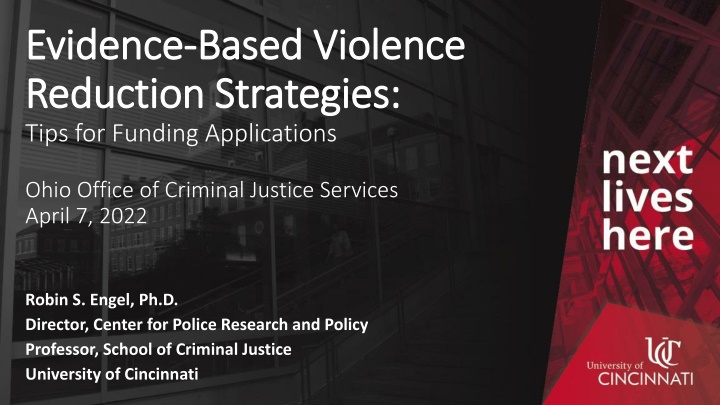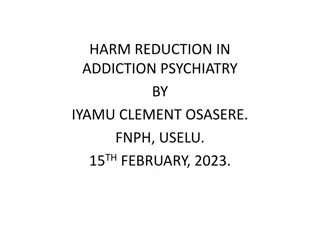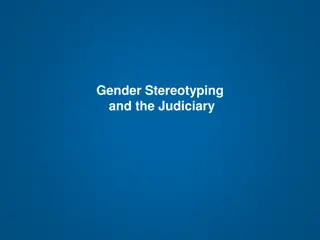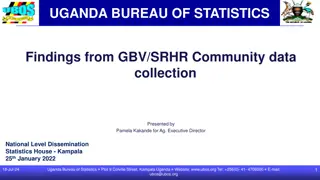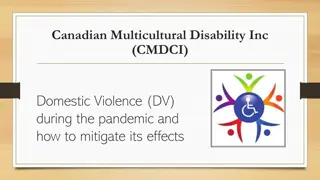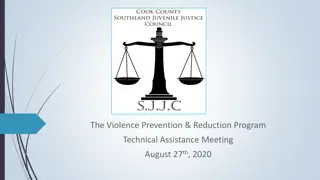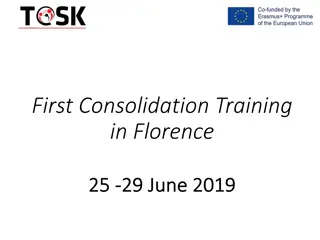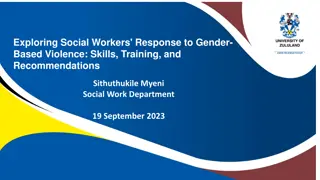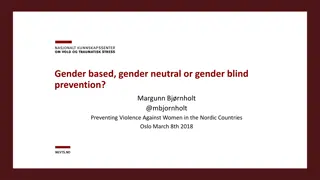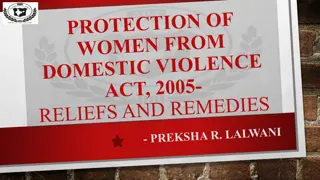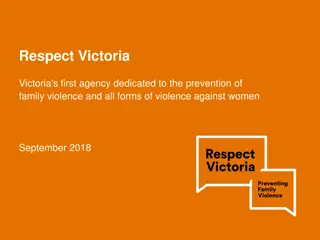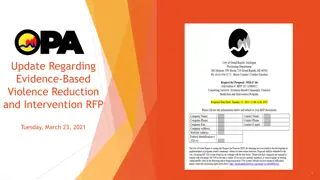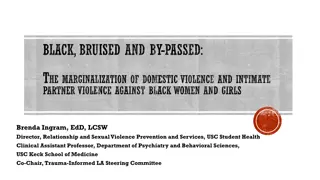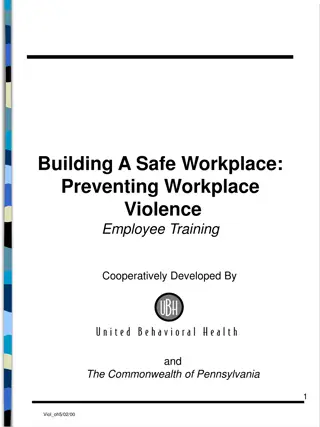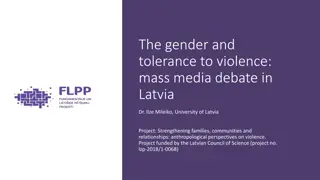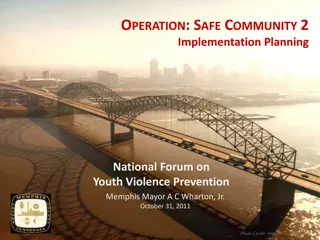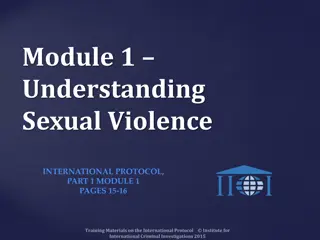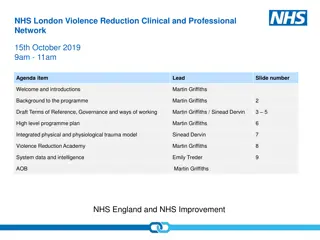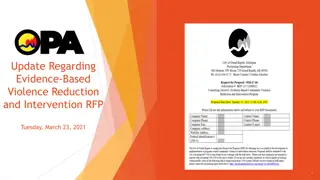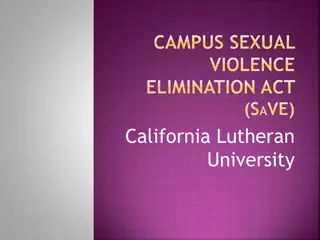Evidence-Based Violence Reduction Strategies and Funding Tips
Strategies to reduce street violence, including urban physical force resulting in serious harm, are discussed along with funding opportunities for various violence types like domestic violence, human trafficking, and mass shootings. Understanding the patterns and implications of violence is crucial in implementing effective violence reduction strategies.
Uploaded on Sep 25, 2024 | 2 Views
Download Presentation

Please find below an Image/Link to download the presentation.
The content on the website is provided AS IS for your information and personal use only. It may not be sold, licensed, or shared on other websites without obtaining consent from the author.If you encounter any issues during the download, it is possible that the publisher has removed the file from their server.
You are allowed to download the files provided on this website for personal or commercial use, subject to the condition that they are used lawfully. All files are the property of their respective owners.
The content on the website is provided AS IS for your information and personal use only. It may not be sold, licensed, or shared on other websites without obtaining consent from the author.
E N D
Presentation Transcript
Evidence Evidence- -Based Violence Based Violence Reduction Strategies: Reduction Strategies: Tips for Funding Applications Ohio Office of Criminal Justice Services April 7, 2022 Robin S. Engel, Ph.D. Director, Center for Police Research and Policy Professor, School of Criminal Justice University of Cincinnati
Defining Violence Strategies reviewed generally seek to reduce street violence Street (Urban) Violence physical force occurring on the street or other public spaces in cities or towns that results (or could result) in serious injury or death Most frequently referring to firearm violence among young (age 24 and under) men Not referring to nonlethal violence, sexual violence, or violence between intimate partners and family members Other types of violence that may be applicable for funding: domestic violence, human trafficking, school-based violence, mass shooting, protest-related violence, etc. Reference: Abt (2019)
Understanding Violence What do Auto Crashes and Street Violence Have in Common? Leading causes of death Serious implications for victims and others Tremendous economic costs Patterns that can be tracked Can be reduced using focused problem solving approaches Holistic approaches are the most effective And the same is true for other types of events and crimes
Understanding Violence: The Crime Triangle and the Power of Repeats Frequency of Crime A few places have most of the crime Some places have a modest amount of crime Most places have little or no crime 0 - Most Crime Places, rank ordered No Crime Source: Wilcox, Pamela & John E. Eck (2011). The Criminology of the Unpopular. Criminology and Public Policy. 10(2):473-482.
Crime Concentrations Among Places, Offenders, and Victims Cumulative % of crimes committed 100 80 60 Places 40 Offenders Victims 20 100 80 20 60 40 % of victims, offenders, places Source: Drawn from Spelman, W. & Eck, J. (1989). Figure 1.
Understanding Violence: The Crime Triangle and the Power of Repeats CRIME CRIME Place Source: Eck, J. (2003). Police Problems: The Complexity of Problem Theory, Research and Evaluation. In, Johannes Knutsson, ed. Problem-Oriented Policing: From Innovation to Mainstream. Crime Prevention Studies, vol. 15. Monsey, NY: Criminal Justice Press.
Understanding Violence: The Crime Triangle and the Power of Repeats CRIME CRIME Place Manager Source: Eck, J. (2003). Police Problems: The Complexity of Problem Theory, Research and Evaluation. In, Johannes Knutsson, ed. Problem-Oriented Policing: From Innovation to Mainstream. Crime Prevention Studies, vol. 15. Monsey, NY: Criminal Justice Press.
Approaches to Violence Reduction Community-Led Founded on public health model; violence as disease Encourages multi-faceted approach for violence prevention Mobilizes community stakeholders for response Police-Led Strategies driven by LE activities and partnerships Primarily based on problem-solving framework Includes offender- , place- , and community-based approaches
Summary of Community-Led Violence Reduction Strategies and Evidence SHORT- TERM IMPACT LONG- TERM IMPACT AMOUNT OF EVIDENCE EVIDENCE RIGOR STRATEGY Communities that Care Moderate High Moderate Moderate Youth Violence Prevention Centers Low Moderate Low Low Cure Violence Moderate Moderate Mixed Mixed PUBLIC-HEALTH BASED PROSPER Low Moderate Low Low Hospital-Based Violence Intervention Programs High High Mixed Mixed OFFENDER-FOCUSED/ PUBLIC HEALTH-BASED HYBRID OJJDP Comprehensive Gang Model Moderate Moderate Mixed Mixed
Summary of Police-Led Violence Reduction Strategies and Evidence LONG- TERM IMPACT AMOUNT OF EVIDENCE EVIDENCE RIGOR SHORT-TERM IMPACT STRATEGY Traditional Gang Enforcement Moderate Moderate Low Low Firearm Crackdowns Low Moderate Low Low Focused Deterrence High Moderate Moderate Low OFFENDER-FOCUSED Project Safe Neighborhoods High Moderate Moderate Moderate Custom Notifications Low Low Unknown Unknown Stop, Question, and Frisk Moderate Moderate Moderate Low Hot Spots Policing High High High Low PLACE-BASED Place-Based Investigations Low Low High Promising Community-Oriented Policing Low Moderate Low Low Broken Windows Policing High High Moderate Low COMMUNITY-BASED Procedural Justice Policing Low High Moderate Unknown
Most Promising Police-led, Evidence-Based Violence Reduction Strategies 1. Hot Spots Deployment 2. Focused Deterrence 3. Place Network Investigations
Hot Spot Policing Focused Deterrence Place Network Investigations Crime Impact Place Place X X X Intervention Focus X X Crime infrastructure Social networks Jurisdiction segments Complexity Partnerships Medium Low High Several Few/None Many Onset & Duration Rapid/Short-term Lagged/Intermediate Deferred/Long-term
Highly focused Evidence-based Strategies Strong investigations / intelligence Key Elements of Successful Initiatives Advanced analytics incorporated from the beginning (e.g., problem analysis); build in testing components Effective partnerships Robust program management / accountability Community support
Learn more about evidence-based violence reduction strategies International Association of Chiefs of Police https://www.theiacp.org/research https://www.theiacp.org/evaluating-violence-reduction-strategies Council on Criminal Justice https://counciloncj.org/violent-crime-working-group/ Center for Evidence Based Crime Policy - https://cebcp.org/evidence-based-policing/what-works-in- policing/research-evidence-review/ Department of Justice https://crimesolutions.ojp.gov/ Urban Institute https://www.urban.org/policy-centers/justice-policy-center/projects/reducing-youth- gun-gang-and-group-violenc Center for Problem-Oriented Policing https://popcenter.asu.edu/ COPS Office https://cops.usdoj.gov/community_violence_intervention
Contact Information Robin S. Engel, Ph.D. Director, Center for Police Research and Policy Professor, School of Criminal Justice University of Cincinnati 513-556-5850 robin.engel@uc.edu www.theiacp.org/research
